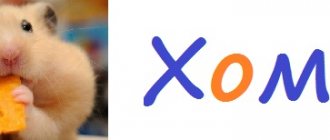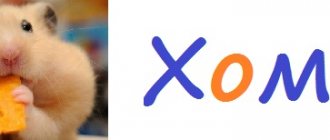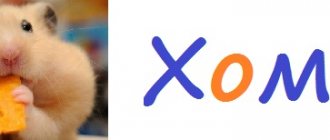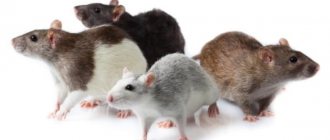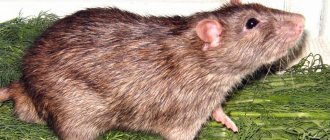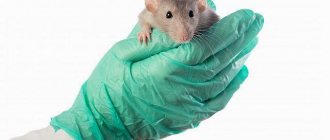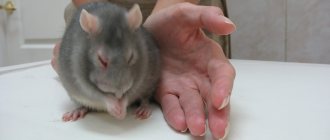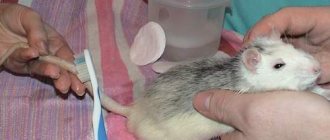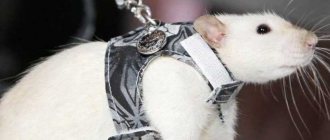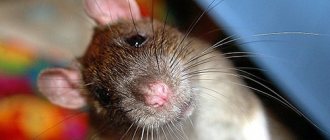- home
- Rat
- Care
07/10/2019 Rat teeth are amazingly sharp and hard. The jaws of a small rodent easily create a pressure of over 1.5 tons per 1 cm². Such jaw power allows the animal to easily bite through lead pipes and steel wire, chew cinder blocks, etc. This article will discuss the characteristics of the teeth of the animal, which is gaining popularity as a pet, as well as the prevention of dental diseases in rodents.
Anatomical features
In most mammals, the chewing surface is arranged in a certain way. Their dentition consists of the following types of teeth:
- incisors;
- molars (or molars);
- premolars;
- fangs.
Unlike most mammals, rats have a more specific jaw structure. The dentition of these rodents includes only two types of teeth out of four possible, these are:
- incisors (only the front ones, these animals have no second ones);
- molars.
The places in the row provided for other types of teeth are empty in rats. Thus, in the dentition of rats there are gaps called diastemas.
Skeleton
Despite its lightness, the skeleton is strong, mobile and elastic.
The skull and its facial part are elongated; the joints of the bones are well developed on the skull. It contains paired coronoid, frontal, parietotemporal, lamboid, interparietal bones and unpaired occipital bones.
The lower jaw can move in three directions: across, along and up.
Like all mammals, the mouse spine is divided into five sections and includes:
- cervical – 7 vertebrae,
- thoracic – 13 vertebrae,
- lumbar – 7 vertebrae,
- sacral – 4 vertebrae, two of which are fused,
- caudal - the number of vertebrae can reach 20.
The sternum is narrow and consists of 13 paired ribs. Some species of mice do not have collarbones, which gives them the ability to crawl through tiny holes.
How many teeth does a rat have
As for the number of teeth in rats, the little animal has 16 of them:
- 4 incisors;
- 12 molars (molars).
On the upper and lower jaws, the arrangement of teeth is the same - according to the 3-2-3 pattern. In the center (i.e., in front) of each jaw there is a pair of incisors, which are surrounded at a distance on both sides by triplets of molars.
Social structure and reproduction
Photo: Male and female Dumbo
The vitality and growth rate of the rat population has become a household name - in nature, rodents reproduce several times a year. Ornamental dambiks are also quite prolific, however, to breed these animals, owners will need to select a healthy pair with pronounced characteristics of the species. These are: a pear-shaped short body and a long narrow tail, as well as a wide flattened head with large round ears.
The first mating of a female should occur at 5-7 months. Pregnancy in Dumbo rats lasts 21-23 days. One litter usually produces 9-12 adorable babies. Dumbo rat pups are born blind and deaf with a naked body. Moreover, not all newborns may have large, round ears - this species characteristic is difficult to preserve. The individual development of babies occurs very quickly. At 4 days of age, they already begin to hear; at 12 days, dambiks open their small eyes. At the age of 2 weeks, the offspring of Dumbo rats are already actively studying their owners and learning about the world around them.
It is very important for the owner of a Dumbo rat to remember that this charming rodent is a social animal. It is very important to provide your pet with communication with both relatives and humans. Systematically conducted outdoor games with this animal, the affectionate formation of precious trust and reverent love - dambiks become attached to only one person for life. Smart rodents have no trouble mastering simple tricks, fetching small objects, finding treats, and even jumping over barriers. Training brings a lot of pleasure to both animals and humans.
Features of incisors
Thanks to their strength, the animals chew through not only wood, bricks and concrete, but even metal. Incisors appear in rat pups a week after birth. Their growth process is accelerated - up to 2-3 mm per week. They reach their usual length by the age of two months. But their growth not only does not stop there, but also does not slow down.
The constant growth of incisors requires regular grinding. Excess length causes many problems, including the death of the animal.
They are covered with enamel only on the front. The back surface is covered with a soft, fast-wearing substance called dentin. This heterogeneous coating determines the sharpness of the incisors.
Feeding
These pets are quite unpretentious in their choice of food, but are not omnivorous, like ordinary ones. Decorative rats are very gentle creatures, often having problems with the intestines and allergies.
Its menu should include:
- grain base - it is better to purchase a special mixture for rodents in pet stores. It should make up 60% of the total diet. You can also feed with unprocessed pumpkin, flax or sunflower seeds;
- proteins - occasionally (1-2 times a week) give a little meat (raw or boiled), chicken, yogurt, cottage cheese, eggs will benefit your pet;
- herbs - parsley, cilantro, dandelion, dill, plantain, radish tops;
- vegetables and fruits (preferably boiled) - apples, bananas, carrots, white cabbage, cucumbers, tomatoes, pumpkin, eggplant, potatoes. Citrus fruits must be treated selectively - they can cause allergies in your pet;
- delicacies - grain sticks, nuts, dates, berries, dried fruits, raisins, crackers (unsalted only), unsweetened cookies, boiled pasta, boiled shrimp and seafood.
It is necessary to give fish oil and specialized vitamins. Animals are fed 2 times a day: morning and evening. The exception is pregnant rats - they are fed 4-5 times a day. If you adhere to the basic requirements for what to feed your rat Dumbo, he will be healthy and cheerful.
If your pet refuses to eat for 1-2 days, you should immediately show him to a veterinarian!
Prohibited Products
If the owner is interested in his pet living as long and healthy as possible, the following products should be avoided:
- chocolate and products containing it;
- other sweets;
- sausage and frankfurters;
- canned food for people;
- raw beans and other legumes;
- cheeses (especially blue and salted);
- soda;
- sprouted potatoes;
- Brussels sprouts and red cabbage;
- green bananas;
- spinach;
- beet;
- fatty and salty foods.
Knowledge of what can and cannot be given to decorative rats will help you correctly formulate the rodent’s menu and avoid unnecessary worries and health problems.
Home care
To prevent dental disease in your animal, it is important to properly care for your pet. Caring for a rat's incisors involves providing the animal with hard materials for grinding. These are special items that an animal can chew with benefit for its teeth:
- toys;
- bars, etc.
If the rodent does not have access to such materials, it may begin to grind down the incisors on its own. At the same time, the animal makes a sound with its jaws, similar to tapping.
If the continuously growing incisors are not ground down in time, this will lead to their curvature, bending and other deformations that cause suffering to the animal.
Individuals with malocclusion need special precautionary care. They are not able to properly grind off excess length, so the responsibility for shortening lies with the owner of such an animal.
You can help the animal by cutting the enamel. Don’t be afraid to trim your rat’s teeth - this procedure does not take much time and, moreover, it is painless for the animal (the enamel is not connected to the nerve endings). The enamel only needs to be trimmed a few millimeters.
General characteristics of the animal
Depending on the species, the length of a rat’s body can range from 8 to 30 cm. A distinctive feature is a long tail, sometimes exceeding the length of the body. The weight of the animal ranges from 37-400 g. Particularly large individuals of gray rats can reach a weight of 0.5 kg.
Classic shades of wool are gray and brown, although yellow and orange colors are also found. The main types of wild rats are gray and black, widespread everywhere. The rest of the rodents live in a strictly defined area.
The following breeds are best suited for home keeping:
- standard - large animals with a long tail and smooth fur;
- satin - the animals are covered with a thin six, curling blue;
- Dumbo - funny animals with a wide head, pear-shaped body and large round ears;
- Sphynx - hairless rats with pink shiny fur;
- tailless - a distinctive feature is the complete absence of a tail.
The structure of molars
Molars are wide and flat in shape. Interestingly, rats do not chew, but grind food using molars. When an animal eats, its jaws do not move up and down, but back and forth. Moreover, only one of the jaws moves. Thus, the food does not crumble, but is ground, after which the animal swallows it.
For better grinding of food, ridges and tubercles are provided on the molars. Enamel covers only the sides of the molars - the middle has a dentin coating. It is worth noting that the enamel is very durable - its hardness coefficient is 5.5 (for comparison, for diamond it is 10).
Molars in baby rats erupt alternately from near to far:
- on the 19th day of birth - the first two pairs;
- on the 21st day - the second batch;
- by 4–5 weeks – the third ones complete the dentition.
A six-week-old rodent already has a full set of teeth. Molars grow until the animal is 4 months old, then growth gradually stops.
Disease Prevention
To help your pet stay healthy and alert, you need to monitor the condition of his jaws and teeth. Owners should be alert to the following dangerous symptoms:
- wounds on the mucous membranes of the cheeks and lips;
- knocking sound that appears when eating;
- increased salivation;
- loss of appetite;
- swelling of the tongue or mucous membrane;
- abscess formation.
In each of these cases, it is necessary to contact a specialist in time. The veterinary clinic usually conducts an examination, testing for bacterial microflora, and treating the oral cavity with local antiseptics. Also, if necessary, the doctor can trim or grind the incisors, correct the bite and give recommendations on proper care.
The assortment of pet stores will also help you deal with all possible problems in a timely manner.
A ratologist is responsible for the health of rats. For questions regarding maintenance, treatment and other assistance, please contact tel. +7 (495) 669-31-09 (Moscow); (Saint Petersburg)
Ratologists work around the clock:
| Services | Prices |
| Ratologist is on call from 9.00 to 21.00 | 600rub |
| Ratologist is on call from 21.00 to 9.00 | 1200rub |
| Initial examination of the rat | from 500r |
| Cost of a doctor's consultation visit | up to 2000r |
| Average cost of a visit to provide medical care | from 2000 rub. up to 4000 rub. |
| Average cost of surgical procedures | 3000rub |
Please note that a ratologist’s visit consists of a Doctor’s Call, an Examination of the animal and Additional therapeutic measures.
Source
Mineral composition
A rat's teeth are made up of three layers:
- pulp;
- dentin;
- enamel.
Pulp is the soft core. This is a concentration of nerve canals and blood vessels. The pulp is surrounded by a harder layer of dentin. Its thickness exceeds the layers of pulp and enamel combined.
The outer coating – enamel – is the hardest and most durable. The enamel crown contains mineral components, the main one being calcium.
In Novosibirsk there is a monument to laboratory rats and mice
Photo: Irina Gelbukh / Wikimedi
The monument, 1.82 meters high, is located in the courtyard of the Institute of Cytology and Genetics in Novosibirsk. A bronze rodent knitting a DNA double helix, with a small pince-nez on its nose, is installed in memory of the rodents used in laboratory tests. Between 85 and 95% of animals used in laboratories are rodents, including rats, mice, hamsters and gerbils. In the United States alone, 100 million rodents are tested annually.
Why do rats have yellow teeth?
Thanks to the vertical groove under the rodent's nose, its upper incisors are constantly visible, even when the animal's mouth is closed. Because of this feature, it is clearly visible that the rat has yellow teeth.
Initially, the rodent's incisors are white, but by the 21st day of life, the upper ones acquire a yellow tint. By the 25th day, the upper incisors are already completely covered with yellow pigment, and the lower ones are just beginning to turn yellow.
By the 38th day, the lower ones acquire a rich yellow color, but the upper ones by that time become even more pigmented. Rat teeth retain this difference in the density and richness of the yellow color throughout the animal’s life. In adults, the upper incisors are a rich dark red color, while the lower ones are still colored yellow.
What to name the animal
You shouldn't give your pet the first name that comes to mind.
It is advisable to choose names for your pet that will highlight its individuality. To choose the right one, you can rely on the recommendations of experienced rat breeders.
- There is no need to rush to give your Dumbo rat the first name you like. You need to take a closer look at the pet, observe it, and note its characteristic behavioral features.
- Each pet is special to its owner and has the right to a “special” name. Therefore, you should not stop at the usual names for rats, but choose an original one.
- If there are several animals, they can be given names from the same category. For example, the names of the planets are suitable.
- Hints in choosing a name can be found in fairy tales, cartoons or nursery rhymes.
It is important to choose a name that can be changed to a diminutive. This is what the owner will most often call his charming pet with big ears.
Dumbo the rat is one of the best pets. Communication with him is always interesting and evokes a lot of positive emotions. Taking care of a rodent is not difficult, and food costs are low.
